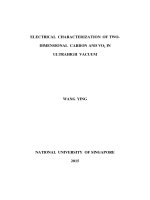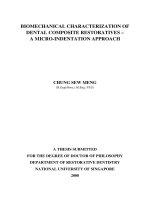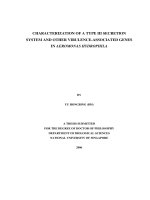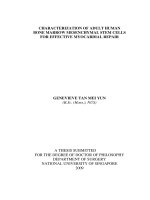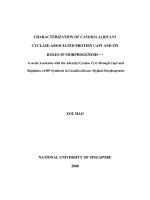Characterization of spherical metamaterials
Bạn đang xem bản rút gọn của tài liệu. Xem và tải ngay bản đầy đủ của tài liệu tại đây (1.72 MB, 140 trang )
CHARACTERIZATION OF SPHERICAL METAMATERIALS
BY
HUANG NINGYUN
B.ENG. COMMUNICATION ENGINEERING
XIAN JIAOTONG UNIVERSITY, 2000
A THESIS SUBMITTED
FOR THE DEGREE OF MASTER OF ENGINEERING
DEPARTMENT OF ELECTRICAL AND COMPUTER ENGINEERING
NATINAL UNIVERSITY OF SINGAPORE
2004
@ National University of Singapore, All Right Reserved 2004
i
ACKNOWLEDGEMENT
I indeed feel great pleasure to express my sincere gratitude to my supervisor Professor Li
Le-Wei, for his valuable guidance, advice, strong support and many useful opinions and
suggestions on many parts of the research work in the process of my postgraduate
program. I would like to particularly acknowledge and thank Prof. Li who has given me
continual help and great encouragement, which have always inspired me to work harder
and have given me confidence.
I am also very grateful to Professor Leong Mook Seng and Professor Yeo Tat Soon for
their kind encouragement and helpful suggestions.
My gratitude is also extended to my fellow laboratory members and many friends in
Microwave Division, for their kind help and advice when I encountered some difficulties
in the project.
Last but not least, I take this opportunity to express my deep thanks to my beloved
parents and younger sister for their encouragement and support.
Huang Ningyun
15 March 2004
Table of Contents
1
TABLE OF CONTENTS
ABSTRACT ……………………………………………………………………………..I
ACKNOWLEDGEMENT ……………………………………..………………………II
1
2
INTRODUCTION....................................................................................................... 1
1.1
PROBLEM DESCRIPTION ....................................................................................... 1
1.2
MOTIVATION AND OBJECTIVES ............................................................................ 2
1.3
OUTLINE OF THE THESIS ...................................................................................... 2
1.4
ORIGINAL CONTRIBUTION.................................................................................... 3
BACKGROUND INTRODUCTION OF METAMATERIAL............................. 5
2.1
NEGATIVE REFRACTIVE INDEX ............................................................................ 5
2.2
NEGATIVE REFRACTION MAKES A PERFECT LENS ............................................... 8
2.3
LATERAL DISPLACEMENT
OF
A
GAUSSIAN BEAM REFLECTED FROM
A
GROUNDED METAMATERIAL ........................................................................................... 9
3
2.3.1
Numerical Results ....................................................................................... 9
2.3.2
Simulation Results..................................................................................... 14
SPHERICAL DYADIC GREEN’S FUNCTIONS............................................... 17
3.1
INTRODUCTION .................................................................................................. 17
3.2
FUNDAMENTAL FORMULATION .......................................................................... 19
3.2.1
Eigenfunction Expansion of DGF in Unbounded Media.......................... 19
Table of Contents
2
3.2.2
DGFs for Spherical Multilayered Media.................................................. 23
3.2.3
The Recurrence Matrix Equations for the Coefficients of Scattering DGFs
24
3.3
4
SCATTERING OF SPHERE ................................................................................ 30
4.1
Rayleigh Scattering................................................................................... 30
4.1.2
Mie Scattering........................................................................................... 32
SCATTERING BY TWO SPHERES .......................................................................... 36
METAMATERIAL SPHERE................................................................................ 44
5.1
INTRODUCTION .................................................................................................. 44
5.2
CURRENT DISTRIBUTION LOCATED OUTSIDE THE SPHERE ................................. 44
5.2.1
Introduction............................................................................................... 44
5.2.2
Using Two Methods to Obtain the Coefficients ........................................ 45
5.2.3
Coefficients in the Special Case of Metamaterial..................................... 48
5.2.4
Calculation of the Electrical Field ........................................................... 51
5.3
6
INTRODUCTION .................................................................................................. 30
4.1.1
4.2
5
CONCLUSIONS .................................................................................................... 29
CURRENT DISTRIBUTION LOCATED INSIDE THE SPHERE .................................... 54
5.3.1
Introduction............................................................................................... 54
5.3.2
The Calculation of the Coefficients........................................................... 55
5.3.3
Coefficients in the Special Case of Metamaterial..................................... 57
5.3.4
Calculation of the Electrical Field ........................................................... 61
METAMATERIAL SPHERICAL SHELL.......................................................... 65
Table of Contents
6.1
INTRODUCTION .................................................................................................. 65
6.2
CURRENT DISTRIBUTION LOCATED OUTSIDE THE SPHERICAL SHELL ................. 65
6.2.1
Introduction............................................................................................... 65
6.2.2
The Calculation of the Coefficients........................................................... 66
6.2.3
Coefficients in the Special Case of Metamaterial..................................... 70
6.2.4
Calculation of the Electrical Field ........................................................... 73
6.3
7
3
CURRENT DISTRIBUTION LOCATED INSIDE THE SPHERICAL SHELL .................... 76
6.3.1
Introduction............................................................................................... 76
6.3.2
The Calculation of the Coefficients........................................................... 77
6.3.3
Coefficients in the Special Case of Metamaterial..................................... 80
6.3.4
Calculation of the Electrical Field ........................................................... 83
MULTI-SPHERICAL LAYERS OF METAMATERIALS ............................... 87
7.1
INTRODUCTION .................................................................................................. 87
7.2
CURRENT DISTRIBUTION LOCATED OUTSIDE THE SPHERICAL MULTILAYERS .... 87
7.2.1
Introduction............................................................................................... 87
7.2.2
The Calculation of the Coefficients........................................................... 88
7.2.3
Coefficients in the Special Case of Metamaterial..................................... 93
7.2.4
Calculation of the Electrical Field ........................................................... 95
7.3
CURRENT DISTRIBUTION LOCATED INSIDE THE SPHERICAL MULTILAYERS ....... 99
7.3.1
Introduction............................................................................................... 99
7.3.2
The Calculation of the Coefficients......................................................... 100
7.3.3
Coefficients in the Special Case of Metamaterial................................... 104
4
Table of Contents
7.3.4
8
Calculation of the Electrical Field ......................................................... 106
SIMULATION RESULTS ................................................................................... 110
8.1
SIMULATION RESULTS AND DISCUSSION OF METAMATERIAL SPHERE ............. 110
8.2
SIMULATION RESULTS
AND
DISCUSSION
OF
METAMATERIAL SPHERICAL SHELL
114
8.3
SIMULATION RESULTS
AND
DISCUSSION
OF
METAMATERIAL SPHERICAL
MULTILAYERS ............................................................................................................. 118
9
SUMMARY ........................................................................................................... 125
REFERENCES.............................................................................................................. 127
Abstract
i
Abstract
Materials possessing both negative permittivity and permeability simultaneously, i.e.,
left-handed materials or metamaterials were firstly introduced in 1968 by V.G.Veselago.
This special kind of materials demonstrates very different characteristics from the
conventional materials. In this thesis, the electromagnetic fields produced by a dipole in
the presence of metamaterial spheres are analyzed.
Firstly, some properties of metamaterial, including negative refractive index and lateral
displacement of a Gaussian beam reflected from a grounded metamaterial, are introduced
and discussed. Secondly, spherical dyadic Green’s functions in such a material are
analyzed, and the eigenfunction expansion of DGF and the recurrence matrix equations
for the coefficients of scattering DGF are emphasized. Thirdly, the scattering of normal
material sphere is introduced. Scattering by two separate spheres is analyzed in particular.
Finally, the spherical metamaterial objects are analyzed. Three cases are considered
respectively: the single sphere, the spherical shell and the multi-layer sphere. Finally,
simulation results are given and discussed.
List of Figure
1
List of Figures
Fig 2.1: A medium with negative refractive index bend light to a negative angle with the
surface normal. Light formerly diverges from a point source and then set in reverse
and converges back into a point. The light reaches a focus for a second time after it
released from the medium........................................................................................... 8
Fig 2.2: Configuration of a Gaussian beam incident upon a slab with thickness
d = d 2 − d1
.................................................................................................................. .10
Fig 2.3: Time-averaged power density on the xz plane for a 30° incidence of a Gaussian
beam upon a grounded slab of thickness d = 6λ with ε1 = ε 0 and µ = µ0 . This is
the simulation result by using the formula developed in this thesis ......................... 15
Fig 2.4: Reference time-averaged power density on the xz plane for a 30° incidence of a
Gaussian beam with ε1 = ε 0 and µ = µ0 . This is the simulated result by using the
formula developed in reference [6]........................................................................... 15
Fig 2.5: Time-averaged power density on the xz plane for a 30° incidence of a Gaussian
beam upon a grounded slab of thickness d = 6λ with ε1 = −ε 0 and µ = − µ0 . This is
the simulation result by using the formula developed in this thesis ......................... 16
Fig 2.6: Time-averaged power density on the xz plane for a 30° incidence of a Gaussian
beam upon a grounded slab of thickness d = 6λ with ε1 = −ε 0 and µ = − µ0 . This is
the simulated result by using the formula developed in reference [6] ...................... 16
List of Figure
2
Fig 3.1: Geometry of a spherically multilayered medium ................................................ 18
Fig 8.1: Structure of the metamaterial sphere. ................................................................ 110
Fig 8.2: Near field of metamaterial sphere when k2 = k1 = k0 , a = 1λ , b = 2λ ............ 112
Fig 8.3: Near field of metamaterial sphere when k2 = 2k1 , a = 1λ , b = 2λ . ................. 112
Fig 8.4: Near field of metamaterial sphere when k2 = 4k1 , a = 1λ , b = 2λ .................. 113
Fig 8.5: Near field of metamaterial sphere when k2 = − k1 , a = 1λ , b = 2λ ............. …113
Fig 8.6: Near field of metamaterial sphere when k2 = −2k1 , a = 1λ , b = 2λ . ............... 114
Fig 8.7: Structure of the metamaterial spherical shell. ................................................... 115
Fig 8.8: Near field of metamaterial spherical shell when k2 = k1 , a1 = 4λ , a2 = 2λ ... 116
Fig 8.9: Near field of metamaterial spherical shell when k2 = 2k1 . a1 = 4λ , a2 = 2λ .. 116
Fig 8.10: Near field of metamaterial spherical shell when k2 = − k1 , a1 = 4λ , a2 = 2λ .117
Fig 8.11: Near field of metamaterial spherical shell when k2 = −2k1 , a1 = 4λ , a2 = 2λ 117
Fig 8.12: Structure of the spherical mutilayers ( m = 5 ). ................................................ 118
Fig 8.13: Near field of 5-layer metamaterial spheres when k2 = k1 , a1 = 4λ , a2 = 3.5λ ,
a3 = 2.5λ , a4 = 2λ , b = 5λ . ................................................................................... 119
List of Figure
3
Fig 8.14: Near field of 5-layer metamaterial spheres when k2 = 2k1 , a1 = 4λ , a2 = 3.5λ ,
a3 = 2.5λ , a4 = 2λ , b = 5λ ................................................................................... 119
Fig 8.15: Near field of 5-layer metamaterial spheres when k2 = −k1 , a1 = 4λ , a2 = 3.5λ ,
a3 = 2.5λ , a4 = 2λ , b = 5λ , n = 10 . ....................................................................... 120
Fig 8.16: Near field of 5-layer metamaterial spheres when k2 = − k1 , a1 = 4λ , a2 = 3.5λ ,
a3 = 2.5λ , a4 = 2λ , b = 5λ , n = 20 ....................................................................... 120
Fig 8.17: Near field of 5-layer metamaterial spheres when k2 = − k1 , a1 = 4λ , a2 = 3.5λ ,
a3 = 2.5λ , a4 = 2λ , b = 5λ ., n = 30 ...................................................................... 121
Fig 8.18: Near field of 5-layer metamaterial spheres when k2 = − k1 , a1 = 5λ , a2 = 4λ ,
a3 = 3λ , a4 = 2λ , b = 5.5λ , n = 30 ....................................................................... 121
Fig 8.19: Near field of
5-layer metamaterial spheres when k2 = −2k1 ,
a1 = 4λ ,
a2 = 3.5λ , a3 = 2.5λ , a4 = 2λ , b = 5λ , n = 20 ..................................................... 122
Fig 8.20: Near field of
5-layer metamaterial spheres when k2 = −2k1 ,
a1 = 4λ ,
a2 = 3.5λ , a3 = 2.5λ , a4 = 2λ , b = 5λ , n = 30 ..................................................... 122
Fig 8.21: Near field of 5-layer metamaterial spheres when k2 = −2k1 , a1 = 5λ , a2 = 4λ ,
a3 = 3λ , a4 = 2λ , b = 5.5λ , n = 30 ........................................................................ 123
List of Symbols
List of Symbols
E:
Electric field
H:
Magnetic field
k:
Wave number
k0 :
Wave number in free space
λ:
Wave length]
λ0 :
Wave length in free space
f
:
Frequency
ω:
Angular frequency
ε:
Permittivity
nc :
Refractive index
µ:
Permeability
εr :
Relative permittivity
µr :
Relative permeability
ε0 :
Permittivity in free space
µ0 :
Permeability in free space
Chapter1
1
Introduction
1 INTRODUCTION
1.1 PROBLEM DESCRIPTION
In 1968, metamaterial, a kind of artificial materials with the electric permittivity and
magnetic permeability simultaneously negative was firstly introduced by V.G. Veselago,
who predicted that if such a material could be found, it would exhibit very unusual
electromagnetic scattering phenomena. In recent years, the electromagnetic properties of
this kind of special materials have attracted much attention. Such metamaterial has
optical properties that would be impossible to be found in a conventional material and
could make novel antennas or perfect optical lenses theoretically. Metamaterials can be
engineered to have specific electromagnetic behaviors that are physically impossible for
natural materials. Now, in this thesis, we focus on the electromagnetic properties of a
spherically multilayered medium, which is metamaterial. The spectral-domain
electromagnetic Dyadic Green’s Function is constructed for defining the electromagnetic
fields in the multilayered media. The scattering dyadic Green’s function in each layer is
constructed and the coefficients of the function are derived. The general solution can be
applied to specific geometries, e.g., two-, three- and four-layered media which are
frequently employed in practical cases. Boundary conditions are also used to solve this
problem. Results and discussions are given in succession.
1
Characterization of Spherical Metamaterials
Chapter1
Introduction
2
1.2 MOTIVATION AND OBJECTIVES
The research aims to obtain electromagnetic radiation characteristics of a dipole in each
layer of the spherically multilayered media. The metamaterial exhibits different
properties from other conventional materials, such as opposite electromagnetic wave
phase velocity. Accordingly, the media made of metamaterial will show a different
electromagnetic radiation pattern. This is what we are interested in. Metamaterial’s
special properties are also very beneficial in potential practical uses. The simulation
results of models with different layers are given and discussed.
1.3 OUTLINE OF THE THESIS
The thesis is divided into 8 chapters, as follows:
Chapter 2 gives the basic information about this thesis by providing an overview of
background knowledge for the metamaterials.
The Chapter 3 gives thorough description about spherical dyadic Green’s functions,
which are used in this project. Some necessary implementations of the theories used in
the thesis are also provided here.
In Chapter 4, detailed description regarding the scattering by spheres is provided. The
scattering of two spheres is emphasized.
2
Characterization of Spherical Metamaterials
Chapter1
Introduction
3
Chapter 5 analyzes the fields associated with a single sphere, using the spherical dyadic
Green’s function. Two circumstances are considered: the source locates outside the
sphere and inside the sphere, respectively. The specific case, i.e., the metamaterial sphere
case, is also studied.
Chapter 6 analyzes the fields associated with a spherical shell. Similar to those in Chapter
5, two cases are considered where the source locates outside the sphere shell and inside
the sphere shell, respectively, and also examined is the specific case of metamaterial
sphere.
In Chapter 7, the general case is considered where spherical multilayer is involved, with
the source set to be outside the layers and inside the layers, respectively. The
metamaterial case is considered.
In Chapter 8, the simulation results of the single sphere and spherical multi layers are
given.
Chapter 9 gives a summary of the whole thesis.
1.4 ORIGINAL CONTRIBUTION
Conference paper:
3
Characterization of Spherical Metamaterials
Chapter1
Introduction
4
Le-Wei Li, Ningyun Huang, Qun Wu and Zhong-Cheng Li, "Macroscopic Characteristics
of Electromagnetic Waves Radiated by a Dipole in the Presence of Metamaterial Sphere
({Invited})", Proc. of 5th Asia-Pacific Engineering Research Forum on Microwaves and
Electromagnetic Theory, Kyushu University, Fukuoka, Japan, July 29-30, 2004
4
Characterization of Spherical Metamaterials
Chapter 2
Background and Introduction of Metamaterial
5
2 BACKGROUND INTRODUCTION OF METAMATERIAL
After metamaterial was first introduced in 1968 by Veselago[3], many scientists have
tried to realize it in the real world. A composite medium, based on a periodic array of
interspaced conducting, nonmagnetic copper split ring resonators and continuous wires,
which exhibits a frequency region in the microwave regime with simultaneously negative
values of effective permeability µ and permittivity ε , forms a metamaterial. It has been
predicted that such phenomena as the Doppler Effect, the Cerenkov radiation, and the
Snell’s law are inverted. The shape of the ring can be both circular and square. The rings
and wires are on opposite sides of the boards. The structure is improved for better
material characteristics in the following years.
In this chapter some basic properties of the metamaterial are presented. The negative
refractive index of metamaterials is introduced firstly; then the lateral displacement of
Gaussian beam reflected from grounded metamaterial is introduced afterwards.
2.1 NEGATIVE REFRACTIVE INDEX
The real part of the refractive index of a nearly transparent and passive medium is usually
taken to have only positive values. Through an analysis of a current source radiating into
a metamaterial, it can be determined that the sign of the real part of the refractive index is
actually negative. The regime of negative index leads to unusual electromagnetic wave
5
Characterization of Spherical Metamaterials
Chapter 2
Background and Introduction of Metamaterial
6
propagation and merits further exploration. The negative refractive index can be derived
from the analysis of the equation of the electric field and the equation of the work. The
general solution to the one-dimensional wave equation with an arbitrary current density,
in frequency domain, can be written as [7]:
E (ω ) = − z (ω )
j (ω )
,
c
(2.1)
where the generalized impedance can be defined [7] as:
z (ω ) =
µ (ω )
,
n(ω )
(2.2)
where n is refractive index. We require that the source on average do positive work on
the fields. Thus we define the quantity
P (ω ) =
j (ω )
1
z (ω )
2
c
2
,
(2.3)
which should be greater than zero [7]. In order to make sure the positive work, we get
z (ω ) > 0. In a metamaterial, since µ < 0 , we conclude that the solution with n < 0 leads
to the correct interpretation that the currents perform work on the fields.
The existence of negative refractive index is consistent with causality, which introduces
the constraints:
d [ε (ω )ω ]
dω
> 1 and
d [ µ (ω )ω ]
dω
> 1,
(2.4)
valid for nearly transparent media. Wave propagation and wave interaction with current
sources in metamaterial are therefore necessarily complicated by the implicit frequency
dependence of the material parameters, and even simple geometries can lead to
6
Characterization of Spherical Metamaterials
Chapter 2
Background and Introduction of Metamaterial
7
mathematical or numerical complexity. For nearly transparent media, Im [ z (ω )] can be
neglected since it is obtained from the reference [7]:
d (nω ) 1 d
ωµ 1 d (ωε ) 1 d (ωµ )
=
+
(ωε z +
) = z
.
2 dω
2 dω
dω
z
z dω
Applying Eq. (2.4) to Eq. (2.5), we have:
velocity of a wave, defined as vg =
(2.5)
d (nω ) z + z −1
>
> 1. Furthermore, the group
dω
2
c
, must therefore always be positive and less
d (nω )
dω
than c in either normal media or metamaterial. At last, we can find that at some
frequency range, the wave propagates with a negative index of refraction.
We can also get the same result from analyzing the composite medium which is made use
of an array of metal posts to create a frequency region with ε < 0 . The structure is
interspersed with an array of split ring resonators (SRRs) having a frequency region with
µ < 0, which is introduced in the beginning of this chapter. The thin wire medium can be
described by the dielectric function [7]:
ε (ω ) = 1 −
ω 2p
,
ω2
(2.6)
where the plasma frequency ω p is related to the geometry of the wire array.
7
Characterization of Spherical Metamaterials
Chapter 2
Background and Introduction of Metamaterial
8
We can assume that the wire and the SRR arrays do not interact directly, the index of the
refraction of this structure can be presented as: n(ω ) = ε (ω ) µ (ω ). Thus, it can be
obtained that µ and ε are simultaneously negative in the region between ω 0 and ω b , and
there exist propagating modes in this region.
2.2 NEGATIVE REFRACTION MAKES A PERFECT LENS
The sharpness of the image is determined by the wavelength of the light for a
conventional lens. A slab of material with negative refractive index, i.e., a metamaterial
slab, can focus all the Fourier components of a 2D image, even including those do not
propagate in a radiative manner. With the current technology, this kind of super-lenses
can be realized in the microwave band provided that the material has no transmission loss.
Figure 2.1 A medium with negative refractive index bend light to a negative angle with the surface
normal. Light formerly diverges from a point source and then set in reverse and converges back to a
point. The light reaches a focus for a second time after it released from the medium.
8
Characterization of Spherical Metamaterials
Chapter 2
Background and Introduction of Metamaterial
9
Assuming that n = −1, we can seen from the figure that it obeys Snell’s laws of refraction
at the surface as light inside the medium makes a negative angle with the surface normal.
Another characteristic we should notice of this structure is the double focusing effect
revealed. Evanescent waves emerge from the far side of the medium enhanced in
amplitude by the transmission process, so the medium can also cancel the decay of
evanescent waves. This does not violate energy conservation, because evanescent waves
do not transport energy. Several developments in technology make such a lens a practical
possibility, at least in some regions of the spectrum.
2.3 LATERAL DISPLACEMENT OF A GAUSSIAN BEAM REFLECTED FROM A
GROUNDED METAMATERIAL
A dramatic negative lateral shift can be observed when a Gaussian beam reflected from a
grounded metamaterial, which is distinctly different from a shift made by a conventional
grounded slab [6].
2.3.1 NUMERICAL RESULTS
The waves inside and outside the material can be solved analytically from Maxwell’s
equations and the boundary conditions at the interfaces, then, the field values in all
regions can be clearly determined.
A system as shown in Fig. 2.2 has the following incident wave in region “I”:
∞
Eiy = ∫ dk x ei ( kx x + k0 z z )ψ (k x ),
−∞
(2.7)
9
Characterization of Spherical Metamaterials
Chapter 2
Background and Introduction of Metamaterial
10
where
ψ (k x ) =
g
2 π
e− g
2
( k x − kix )2 / 4
.
(2.8)
Y
I ( ε 0 , µ0 )
0
II ( ε1 , µ1 )
d1
θi
III ( ε 2 , µ2 )
d2
X
Figure 2.2 Configuration of a Gaussian beam incident upon a slab with thickness d = d 2 − d1
ˆ ix + zk
ˆ 0 sin θ i + zk
ˆ iz = xk
ˆ 0 cos θ i , where θ i is
The Gaussian beam is centered about k i = xk
the incident angle.
In region “I”, we can obtain the expression of the E 0 y , which is the sum of the incident
wave and reflection wave [6]:
E
∞
0y
= ∫ dkxψ (kx )(eik0 z z + Re−ik0 z z )eikx x .
−∞
(2.9)
Because
10
Characterization of Spherical Metamaterials
Chapter 2
Background and Introduction of Metamaterial
(2.10)
∇ × E = jωµ H
Hx = −
11
1 ∂E y
,
jωµ ∂z
(2.11)
and
1 ∂E y
,
jωµ ∂x
Hz =
(2.12)
we can obtain:
∞
− k0z
−∞
ωµ 0
H 0 x = ∫ dk xψ (k x )
∞
kx
−∞
ωµ 0
H 0 z = ∫ dk xψ (k x )
(e ik0 z z − Re −ik0 z z )e ik x x ,
(2.13a)
(e ik0 z z + Re −ik0 z z )e ik x x .
(2.13b)
In region “II”, we have
∞
E1 y = ∫ dk xψ (k x )( Ae ik1 z z + Be −ik1 z z )e ik x x ,
−∞
∞
− k1 z
−∞
ωµ1
H 1x = ∫ dk xψ (k x )
( Ae ik1 z z − Be −ik1 z z )e ik x x ,
(2.14)
(2.15a)
and
∞
kx
−∞
ωµ1
H 1z = ∫ dk xψ (k x )
( Ae ik1 z z + Be −ik1 z z )e ik x x .
(2.15b)
In region “III”, we have
∞
E 2 y = ∫ dk xψ (k x )Te ik 2 z z +ik x x ,
−∞
(2.16)
thus we can obtain:
∞
− k2z
−∞
ωµ 2
H 2 x = ∫ dk xψ (k x )
Te ik 2 z z +ik x x ,
(2.17a)
11
Characterization of Spherical Metamaterials
Chapter 2
Background and Introduction of Metamaterial
∞
kx
−∞
ωµ 2
H 2 z = ∫ dk xψ (k x )
Te ik 2 z z + ik x x .
12
(2.17b)
The coefficients R , A , B and T can be obtained by matching the boundary conditions
for the tangential components of electric and magnetic fields at x = d1 and x = d 2 .
We apply the boundary conditions:
nˆ × E1 = nˆ × E2 ,
(2.18a)
nˆ × H1 = nˆ × H 2 ;
(2.18b)
Because nˆ = zˆ , then:
zˆ × H 0 z = zˆ × H1z = zˆ × H 2 z = 0 .
(2.19)
Thus we have [6]
when z = d1 ,
zˆ × E0 y = zˆ × E1 y ,
(2.20a)
zˆ × H 0 x = zˆ × H1x ;
(2.20b)
zˆ × E1 y = zˆ × E2 y ,
(2.21a)
zˆ × H1x = zˆ × H 2 x .
(2.21b)
when z = d 2 ,
From (2.20) and (2.21), four equations are derived [6]:
e ik0 z d1 + Re −ik0 z d1 = Ae ik1 z d1 + Be −ik1 z d1 ,
− k0z
ωµ 0
(e ik0 z d1 − Re −ik0 z d1 ) =
− k1 z
ωµ1
( Ae ik1 z d1 − Be −ik1 z d1 ) ,
(2.22a)
(2.22b)
12
Characterization of Spherical Metamaterials
Chapter 2
Background and Introduction of Metamaterial
Ae ik1 z d 2 + Be −ik1 z d 2 = Te ik 2 z d 2 ,
− k1 z
( Ae ik1 z d 2 − Be −ik1 z d 2 ) =
ωµ1
− k2z
ωµ 2
13
(2.22c)
Te ik 2 z d 2 .
(2.22d)
By solving (2.22a-d), we have:
R01 + R12 e i 2 k1 z ( d 2 − d1 ) i 2 k0 z d1
e
,
1 + R01 R12 e i 2 k1 z ( d 2 − d 1)
(2.23a)
A=
2e − i ( k1 z − k0 z ) d1
,
(1 + p 01 ) 1 + R01 R12 e i 2 k1 z ( d 2 − d1 )
(2.23b)
B=
2 R12 e −i ( k1 z − k0 z ) d1 e i 2 k1 z d 2
,
(1 + p 01 ) 1 + R01 R12 e i 2 k1 z ( d 2 − d1 )
(2.23c)
R=
[
]
[
]
4e ik0 z d1 e ik1 z ( d 2 − d1 ) e −ik 2 z d 2
T=
,
(1 + p 01 )(1 + p12 ) 1 + R01 R12 e i 2 k1 z ( d 2 − d1 )
[
]
(2.23d)
where
R01 =
1 − p 01
1 − p12
, R12 =
,
1 + p12
1 + p12
p 01 =
µ 0 k1 z
µk
, p12 = 1 2 z .
µ1 k 0 z
µ 2 k1 z
(2.24a)
(2.24b)
Now we consider the special case that ε 1 = −ε 0 , µ1 = − µ 0 , d 1 = 0 and d 2 = d . Because
region 2 is perfectly conducting and ε 2 is close to infinity, we can simplify the
coefficients R , A , B and T in this special case
k = ω εµ ,
(2.25)
so
k1z = −k0 z ,
(2.26)
13
Characterization of Spherical Metamaterials
Chapter 2
Background and Introduction of Metamaterial
14
and
p01 = 1 , R01 = 0 .
(2.27)
Because k2 z = ω ε 2 µ 2 is close to infinity, p12 is close to infinity, and
R12 = −1 .
(2.28)
We have [6]
R = R12 e i 2 k1 z d = R12 e − i 2 k0 z d = e −i 2 k0 z d ,
A=1,
B = R12 e i 2 k1 z d = R12 e −i 2 k0 z d = e − i 2 k0 z d ,
T=0.
2.3.2
(2.29a)
(2.29b)
(2.29c)
(2.29d)
SIMULATION RESULTS
The time averaged power density for the TE case is given as:
Sn =
2
2
1
Re ( Eny H nz* ) + Re ( Eny H nx* ) ,
2
(2.30)
where n =0,1,2 denotes the regions.
Fig. 2.3 and Fig. 2.5 are the simulation results obtained in this thesis, Fig. 2.4 and Fig. 2.6
are the simulation results in [6]. Fig 2.3 and Fig. 2.4 are the time-averaged power density
for the normal material. Fig. 2.5 and Fig. 2.6 are the time-averaged power density for the
metamaterial.
14
Characterization of Spherical Metamaterials



